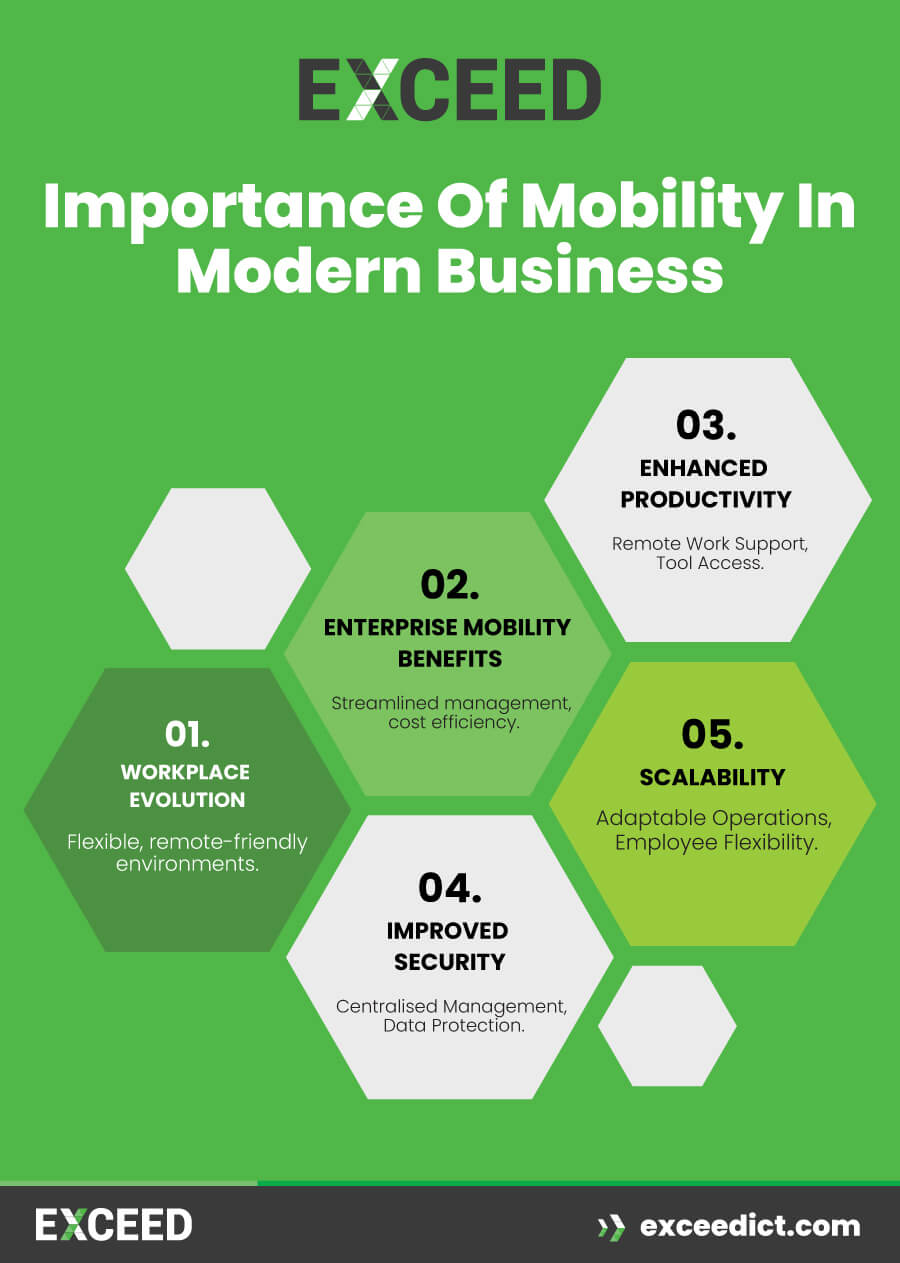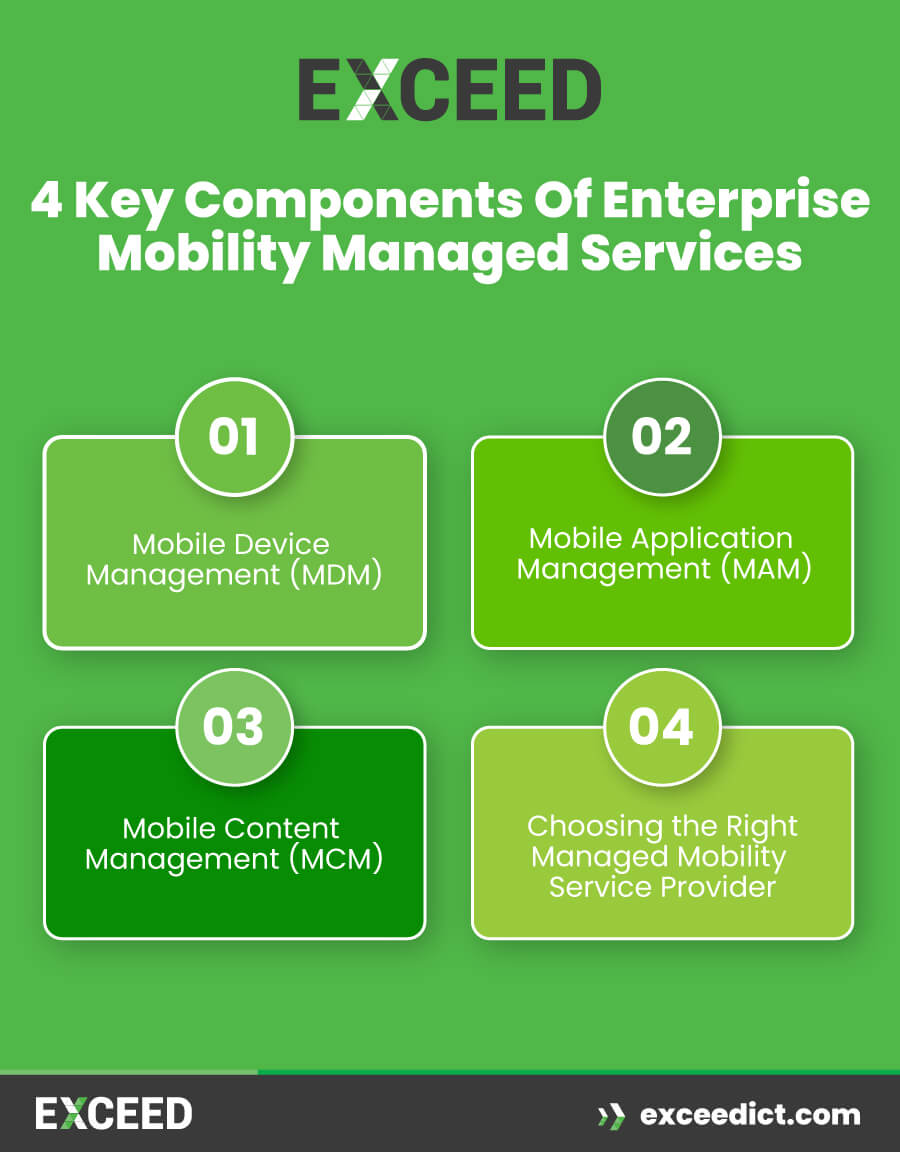
What are Enterprise Mobility Managed Services?
Enterprise Mobility Managed Services (EMMS) are comprehensive solutions provided to businesses to manage and support mobile devices, applications, and services within an organization. These services are designed to enhance productivity, ensure security, and streamline the management of mobile technology. Here are the key components and benefits of Enterprise Mobility Managed Services:
Importance of Mobility in Modern Business

The Evolution of Workplace Mobility:
- Refers to the shift towards more flexible work environments where employees can work from various locations using mobile devices and remote access technologies.
Benefits of Adopting Enterprise Mobility Managed Services
- Includes advantages such as streamlined device management, cost efficiency in device procurement and maintenance, and improved support for employees using mobile devices.
Enhanced Productivity and Efficiency
- Results from enabling employees to work remotely or on the go, reducing downtime, and providing access to necessary tools and resources wherever they are.
Improved Data Security and Compliance
- Achieved through centralised management of devices, secure data storage, encryption protocols, and adherence to regulatory requirements, ensuring data protection and legal compliance.
Scalability and Flexibility in Operations
- Allows organisations to easily adapt to changing business needs, scale operations up or down as required, and provide flexibility to employees in terms of how and where they work.
Key Components of Enterprise Mobility Managed Services

Mobile Device Management (MDM):
- Features and Functions: Provisioning, configuration, and management of mobile devices, including policy enforcement, remote wipe, and device inventory tracking.
- Implementation Best Practices: Enrollment automation, device profiling, and integration with existing IT infrastructure.
Mobile Application Management (MAM):
- Ensuring App Security and Integration: App distribution, version control, and secure app containers to protect corporate data.
- Optimization of App Performance: Monitoring app usage, performance analytics, and troubleshooting.
Mobile Content Management (MCM):
- Secure Access and Storage of Corporate Data: Data encryption, secure file sharing, and rights management.
- Collaboration and Workflow Enhancement: Integration with collaboration tools, document synchronisation, and version control.
Choosing the Right Managed Mobility Service Provider:
- Factors to Consider: Expertise, industry experience, customization capabilities, integration with existing systems, and support services.
Implementing Enterprise Mobility Managed Services: A Step-by-Step Guide

Assessment and Planning:
- Assessing Mobility Needs: Conducting a mobility audit to understand current usage patterns and infrastructure.
- Defining Objectives and KPIs: Establishing measurable goals for the EMMS implementation.
Vendor Evaluation and Selection:
- Evaluating Vendor Offerings: Comparing MDM, MAM, and MCM capabilities, security features, scalability, and compliance with organisational requirements.
- Negotiating Contracts: Establishing SLAs, pricing models, and service guarantees.
Deployment and Integration:
- Pilot Testing: Testing EMMS solutions in a controlled environment to validate functionality and user experience.
- Full-Scale Rollout: Deploying EMMS across the organisation and integrating with existing IT systems.
Challenges and Solutions in Managed Mobility Services
- Security Concerns: Implementing robust security protocols, encryption, and secure access controls to prevent data breaches.
- Compliance: Ensuring adherence to regulatory standards such as GDPR or HIPAA through policy enforcement and data protection measures.
- Cost Management: Optimising costs through transparent billing, expense management tools, and cost-effective deployment strategies.
Future Trends in Enterprise Mobility Managed Services
- 5G and Edge Computing: Leveraging high-speed connectivity and edge computing capabilities for enhanced performance and real-time data processing.
- Artificial Intelligence and Automation: Utilising AI for predictive analytics, automated device management, and personalised user experiences.
- AR and VR: Enhancing user engagement and productivity through augmented reality and virtual reality applications.
By focusing on these components, best practices, and emerging trends, organisations can effectively implement and optimise their Enterprise Mobility Managed Services to meet their strategic objectives while addressing current challenges and preparing for future advancements in technology and mobile workforce needs.
FAQs About Enterprise Mobility Managed Services
What is the difference between MDM and MAM?
Mobile Device Management (MDM) and Mobile Application Management (MAM) are both crucial aspects of managing mobile devices in an enterprise environment, but they serve different purposes:
- MDM (Mobile Device Management) focuses on managing and securing the entire device. It includes features like remote wipe, device encryption, enforcing passcodes, and configuring device settings. MDM solutions are typically used to control company-owned devices.
- MAM (Mobile Application Management), on the other hand, is concerned with managing specific applications and their data on mobile devices. It allows administrators to control access to corporate applications, secure data within those apps, and enforce policies on app usage and data sharing. MAM is often used in scenarios where employees use their personal devices for work (BYOD – Bring Your Own Device).
In summary, MDM manages the entire device, while MAM manages specific applications and their data.
How can managed mobility services improve workforce collaboration?
Managed mobility services can enhance workforce collaboration in several ways:
- Access to Information: Employees can access corporate data and applications from anywhere, facilitating real-time collaboration regardless of location.
- Efficiency: Mobile-enabled workflows streamline processes, reducing delays in communication and decision-making.
- Unified Communication: Integration with collaboration tools such as messaging apps, video conferencing, and document sharing platforms ensures seamless communication.
- Flexibility: Employees can work remotely or on the go, increasing productivity and responsiveness to business needs.
Overall, managed mobility services enable a more connected and productive workforce, leading to improved collaboration.
What are the security risks associated with enterprise mobility?
Enterprise mobility introduces several security risks:
- Data Leakage: Lost or stolen devices can lead to unauthorised access to sensitive company data.
- Malware and Phishing: Mobile devices are vulnerable to malicious software and phishing attacks, compromising data integrity and confidentiality.
- Unauthorised Access: Weak authentication methods or unsecured applications can result in unauthorised access to corporate networks and resources.
- Compliance Issues: Failure to secure mobile devices and data may lead to non-compliance with industry regulations (e.g., GDPR, HIPAA).
To mitigate these risks, enterprises need robust security measures such as encryption, multi-factor authentication, mobile threat detection software, and comprehensive policies for device and application usage.
Is it necessary for small businesses to adopt managed mobility services?
Yes, small businesses can benefit significantly from managed mobility services (MMS):
- Cost Efficiency: MMS providers offer scalable solutions, allowing small businesses to pay for only what they need.
- Enhanced Productivity: Employees can access critical information and collaborate efficiently, regardless of location.
- Improved Security: MMS provides essential security features that protect business data and devices from threats.
While the scale of operations may differ, the need for secure, efficient mobile operations is essential for any business aiming to stay competitive and responsive in today’s digital landscape.
How can enterprises measure ROI after implementing managed mobility services?
Measuring Return on Investment (ROI) for managed mobility services involves several key metrics:
- Productivity Gains: Assess productivity improvements, such as time saved on tasks, faster decision-making, and increased output per employee.
- Cost Savings: Calculate reduced IT support costs, lower hardware expenses (e.g., through BYOD), and minimised downtime.
- Security Enhancements: Quantify avoided costs related to data breaches or compliance violations.
- Employee Satisfaction: Survey employees to gauge satisfaction with mobile capabilities and their impact on job satisfaction.
Looking for top-notch Enterprise Mobility Management Service in Australia?
Contact us on 1300 832 639 for hassle-free Mobility Management Service.
Our experienced team at EXCEED ICT is here to assist you in optimising costs and streamlining processes.
With our award-winning expertise and dedication, we ensure cost reduction and grow your Business.
Find Other Blogs
- Business Mobility Solution Guide to Unlock Max Business Potential.
- Transform Your Business with EXCEED ICT’s Mobility Solutions.
- Telstra Adaptive Mobility for Large Business Success in Australia.
- Telstra Adaptive Mobility for Small Business Success in Australia.
- How Telstra Enterprise Mobility Managed Service Supercharge Your Business.
- Telstra Enterprise Mobility Managed Services by EXCEED ICT.
Stay connected with EXCEED ICT
Stay connected with EXCEED ICT by joining our social networks (given at footer). Get the latest updates, news, and tips for enterprise device deployment. Follow us on Twitter, Facebook, and LinkedIn for the best enterprise device deployment solutions.
Help us to improve our enterprise by rating us for Mobility Managed Service in Australia on Google Maps. Your feedback and comments are valuable to us and will be used to make our services even better.


